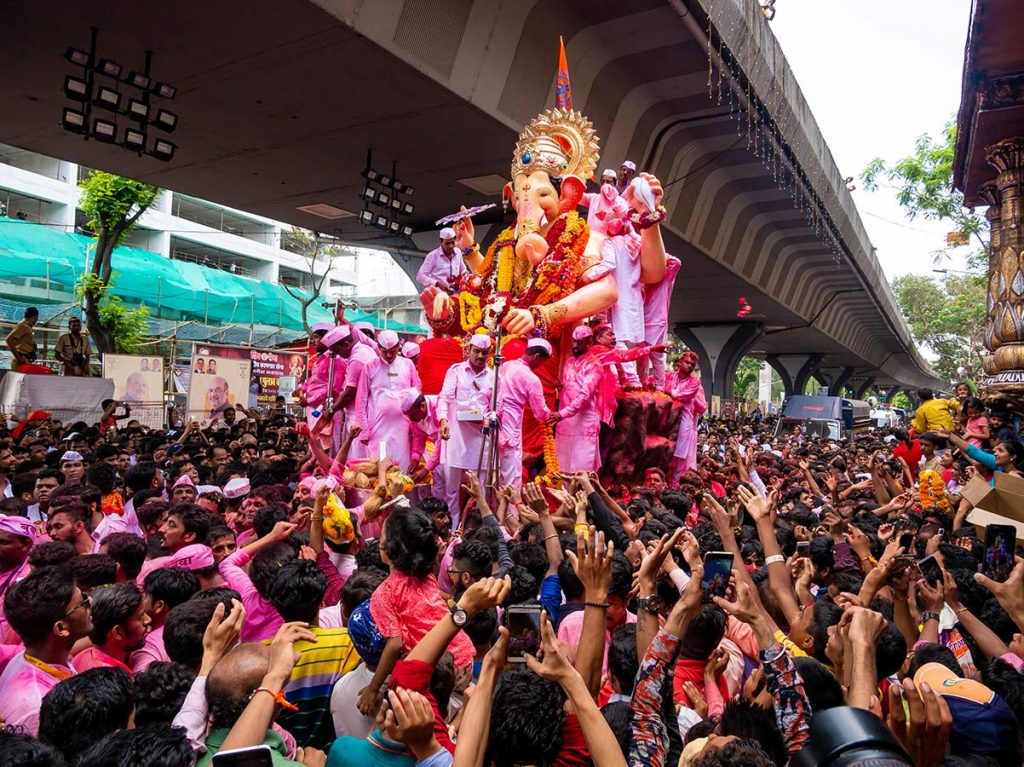Download the full-color, newspaper-page-size PDF of this special festival feature from our Festival Pager Downloads
During Ganesha Chaturthi, a ten-day festival in August/September, elaborate puja ceremonies are held in Hindu temples around the world honoring Ganesha, the benevolent, elephant-faced Lord of Obstacles. In millions of home shrines, worship is also offered to a clay image of Ganesha that the family makes or obtains. At the end of ten days, Hindus join in a grand parade, called visarjana in Sanskrit, to a river, temple tank, lake or seashore, where His image is ceremonially immersed, symbolizing Ganesha’s merging into universal consciousness.
WHO IS GANESHA?
Perennially happy, playful, unperturbed and wise, this rotund Deity removes obstacles to good endeavors and obstructs negative ventures, thus guiding and protecting the lives of devotees. He is the patron of art and science, the God inhabiting all entryways, the gatekeeper who blesses all beginnings. When initiating anything–whether learning, business, weddings, travel, building and more–Hindus seek His grace for success. He is undoubtedly the most endearing, popular and widely worshiped of all the Hindu Deities. Ganesha Chaturthi (also called Vinayaka Chaturthi) falls on the fourth day in the waxing fortnight of the month of Bhadrapada in the sacred Hindu lunar calendar, which translates to a certain day in August-September. It is essentially a birthday celebrating Ganesha’s divine appearance.
WHAT DO PEOPLE DO ON GANESHA CHATURTHI?
Devotees often fashion or purchase a Ganesha statue out of unbaked clay. Many sculpt Him out of a special mixture of turmeric, sandalwood paste, cow dung, soil from an anthill and palm sugar. The Deity image is placed in the home shrine amongst traditional decorations. A rite of worship and prayer, called puja, is conducted daily, invoking the energies of the Deity and inviting Him to reside in the clay image. Mantras are chanted and offerings are made throughout the puja, including incense, lighted lamps, cooked food (naivedya), fruits, durva grass, tulasi and pomegranate leaves–and flowers, especially red ones. After ten days, a simple puja is performed before the statue is taken for a formal departure (visarjana). Often entire communities, from dozens to tens of thousands of devotees, gather each year for this final day of ceremony. The icons are carried on an ornate metal tray–larger images are borne on a palanquin by several strong men–to a lake, a river or the sea. There Ganesha is consigned to the water after removing non-degradable paraphernalia.
WHAT FOODS ARE OFFERED?
Sumptuous foods are specially prepared for Ganesha, keeping in mind His elephantine nature and prodigious appetite. People offer several varieties of fruits such as mangos, bananas and sugarcane. Sweets are the elephant-headed Deity’s delight, so to express their love families take great pains to make special tasty treats. Each family has its recipes.
TIDBITS ABOUT GANESHA
Where is this festival most popular? Nowhere is Ganesha Chaturthi observed with more creativity and enthusiasm than in Mumbai, India. The city virtually shuts down as millions of Hindus celebrate.
Why is He Ganesha worshiped first? Lord Brahma declared that any worship conducted without seeking Ganesha’s blessings would be fruitless. He is considered a loving, playful, protective Deity whose blessings would grace any endeavor. He is therefore ceremonially invoked before weddings, housewarmings, taking an important exam, starting a new business and other important events.
What is His mystical work? Lord Ganesha is the God Hindus pray to when changes occur in their lives as they move from old established patterns into new ones. He is always there to steady the minds of devotees and open the proper doors as they evolve and progress.
What makes Him distinctive? Aside from His unique and endearing elephant head, Ganesha carries an elephant goad to prod us along the right path. He holds a noose to lasso foes of dharma and to draw devotees close when they venture off the spiritual path. His mount is a mouse. His big belly is said to contain the fullness of the cosmos. In His hand is a modaka, fruit or other sweet, symbolic of enlightened attainments.
MODAKA SWEETS
These rich, deep fried, fluffy, sweet dollops are the Mangalorean equivalent of the Tamil kollukattai. It is the all-time favorite of Lord Ganesha, who is described as Modaka Hasta, one with the modaka in His hand.
Preparation time: 10 minutes.
Cooking time: 30 minutes
Makes 20 pieces
Cooking equipment: A wok or deep saucepan, a perforated ladle, a lined colander to drain excess oil, a mixing bowl and serving plate.
INGREDIENTS
4 cups thin beaten rice (poha);
1 cup semolina (rava) flour, 1 cup rice flour, 1 cup slightly over-ripe bananas, mashed, 1 cup powdered jaggery (or brown sugar), 1/8 tsp salt
oil to deep fry
METHOD
1. Mix all the ingredients together except the oil.
2. Add a little water and knead the mixture gently into a thick paste.
3. Heat the oil in the wok.
4. Drop tablespoonfuls of the batter into moderately hot oil and fry till rich brown. Drain and cool, then enjoy!
FACT & FICTION
FACT: There is not just one path to God Realization in Hinduism, but many. Tens of thousands of distinct teaching lineages prescribe varying combinations of prayer, rites and rituals, meditation, chanting and the many yogas to guide followers in their spiritual evolution.
FICTION: Many wrongly believe that Hindus worship cows. Hindus don’t worship cows. They respect, honor and adore the cow. By honoring this gentle animal, who gives more than she takes, Hindus honor all creatures.
